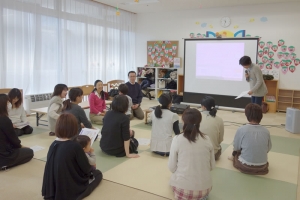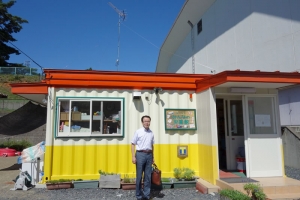Obstetrics and Disaster Preparedness (Part 3 of 3)
Part 3- Perinatal Preparedness and Disaster Remembrance
Nicole Gunawansa | April 20th, 2015
This interview was held on February 18th, 2015 in Tohoku Medical Megabank Building
Question 8: What are the current contingency plans for various types of future disasters relating to obstetrics? How have these plans been altered by 3/11?
There is no standardized plan in Japan relating to disaster obstetrics. People in Miyagi Prefecture/Tohoku region are interested in disaster plan and preparedness; however, the degree of interest varies across Japan depending on their prior experience with disasters. It is the duty of medical professionals and government personal to stress the need for disaster preparedness in general and in obstetrics. What the nation needs is a national/trans-prefecture system. The reality of creating this system is that it will be difficult because people will think that this contingency system is just for disasters. In fact, a standardized plan would not just beneficial in a disaster, but it would also improve the general network of the medical system of Japan. Once people (especially medical professionals) can see this point of view, then effective plans can be set in place for the advancement of Japanese medicine.

Dr. Sugawara has organized two counselling sessions for mothers and infants in Onagawa in 2012 and 2013.
3/11 helped to emphasize the need for contingency plans and increased standardization. We are now making manuals on how build a network and how to share information between pregnant women, the healthcare system, and hospitals. The aim of such communication is to build interactions and relationships between disaster medicine and prenatal medicine. 3/11 has also spurred the creation of the Miyagi Perinatal Program. This program is funded by TOMODACHI Initiative to achieve a global maternal and child support system in the tsunami-affected regions. The two year program, organized by the US-Japan Council, provides counseling and statistical data collection in addition to ALSO® and BLSO® courses for the promotion of disaster recovery and preparation. A new sub-program, the Disaster Nursing and Training Program, will be in its pilot phase this year. Eight selected nursing students and their mentors will visit the USA (Washington DC and New York City) to experience disaster learning for two weeks, and will participate in a Japan based symposium to share their study tour experience.
Before the Great East Japan Earthquake, I was just involved in the affairs of the hospital, but afterwards I feel that it is imperative that people (domestically and internationally) better integrate healthcare systems and disaster preparedness in hope of limiting the destructive capabilities of future disasters.

Two counseling sessions took place in Minamisanriku in 2013.
Question 9: What additional projects would you like to see Tohoku Medical Megabank Organization take on in the future?
I know from my work with ToMMo that there is a lot of recovery focus in the coastal areas of Minamisanriku, Ishinomaki, and Kesennuma. I would like to increase my interaction with the people of those areas, and do seminars with them discussing healthcare, especially obstetrics and gynecology. That is my primary wish. Another interest area is basic research. I would like to have more research projects to clarifying obstetrics issues such as premature labor and pregnancy induced hypertension by using genomics. The introduction of integrative genomics into general obstetric medicine moves our field and the nation towards personalized medicine.
Question 10: In what ways do you think you, or your work has changed from the time of the disaster? Additionally, how far do you think Japan has come since 3/11?
Following the disaster, I have come to realize that life is short. Before 3/11 my focus was on my research and work, but I now know that there are things more important like my family. I am now living for my wife and three children. I have also changed my work goals since the Great East Japan Earthquake as I have now become more focused on working with people both inside and outside of the hospital. The hospital is a very small world, and we need to interact with everyone to build a network for the furtherance of society and the field of obstetrics. Regeneration of local communities affected by the disaster has become my new aim.
Japan still has a long way to go. Although the nation banded together to help immediately following the disaster, the collective effort to uplift Japan has tapered down since 2011. Most people living in Japan seem to have forgotten about the disaster unless it directly impacted them. However, the disaster aftermath still remains as big issue of Miyagi, Iwate, and Fukushima Prefectures. Gradually letting go of the memory of a traumatic event is natural, but it comes as a big limitation for our efforts to motivate people to work together to move Japan forward. I hope that, through my seminars, I can help stimulate people to get more involved in disaster preparedness efforts and honor the memory of those lost during the disaster.
| Comments from the Interviewer Prior to my discussion with Dr. Sugawara, I had not given much thought to obstetrics issues following the Great East Japan Earthquake. When I hear the word disaster, my mind immediately races to trauma: serious medical injuries and the psychological turmoil that accompanies loss. Dr. Sugawara reminded me that the miracle of life (childbirth) happens every day across the world, even during a disaster. Our conversation focused on the fact that expecting or new mothers and their infants deserve the best care regardless of the circumstances, and that it is the obligation of the medical community to ensure that disaster preparedness also applies to obstetrics. Dr. Sugawara also touches upon the topic of memory fading with time. Now four years after 3/11, the disaster seems distant, but the realities of the disaster aftermath are still very real to those living in affected areas. As Dr. Sugawara states, it is important that the Great East Japan Earthquake not be forgotten, and that the Japanese people (across Japan) continue to participate in disaster recovery and preparedness efforts. I believe that this topic is very relevant and vital to keep in mind. In the wake of the ten year anniversary of the Sumatra Earthquake (Dec. 2004), and in preparation for the ten year anniversary of Hurricane Katrina (Aug. 2005), it is our obligation to remember and work to reduce the devastation spurred by natural disaster around the globe. |
